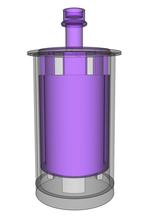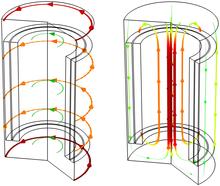
Researchers at the National Institute of Standards and Technology (NIST) have addressed crucial calibration procedures for an advanced rheological technique that can make measurements on the structural dynamics of complex fluids, which is crucial to understanding and predicting the performance of a wide variety of materials ranging from everyday products like shampoos and shaving creams; to biological fluids, like blood and mucus; to food products such as yogurt; and to paints, inks and drilling fluids.
A technique called orthogonal superposition (OSP) rheology, which applies an oscillatory deformation perpendicular to a primary shear flow, allows researchers to gain information on the transient structures formed within complex fluids at the microscopic scale. Rheological properties such as the complex viscosity are quantified from the changes in stress as a function of deformation or the rate of deformation. OSP provides a sensitive measurement of the macroscopic rheology in the complex flow, and this offers insight into the microscale structures that govern these properties.
The OSP technique is now accessible to general rheology experts as a commercially available geometry. Given the complicated flow design, a protocol to quantify measurement error, sources of error, and sensitivity are critical to successful use of the geometry. Unfortunately, many calibration procedures described in the literature are specific to each geometry design and not immediately applicable to the OSP commercial geometry.

In a new paper, Ran Tao and Aaron Forster from the Materials Measurement Laboratory describe a detailed calibration procedure for Newtonian fluids and validate the sources of experimental error through computational fluid dynamics (CFD) simulations [1]. The results show that end-effect corrections should be applied to the OSP technique otherwise significant errors in the measured viscosities may occur. The overestimation of the orthogonal viscosity can be attributed to the pressure forces exerted on the bob-end surfaces and a higher shear rate in the double gap, as was visualized by the CFD simulations of the velocity, pressure, and shear rate distributions within the entire OSP flow cell. In addition, the NIST team provides operational knowledge of the OSP method and outlines an appropriate measurement window such as the range of the fluid viscosity and the measurement frequency to ensure measurement accuracy. The information gained by studying Newtonian fluids provides a benchmark for future studies using non-Newtonian fluids.
The results of this work are critical because of the growing interest from users in different academic institutions and industries who are interested in applying this OSP technique for scientific research and product development. This work is also expected to provide a technical resource and guidance to manufacturers for improvements in the engineering design and manufacturing of their instruments, as well as to guide and inform the development of future documentary standards.
[1] R. Tao, A.M. Forster. End effect correction for orthogonal small strain oscillatory shear in a rotational shear rheometer. Rheol Acta 2020, 59, 95–108. DOI: 10.1007/s00397-019-01185-5.

